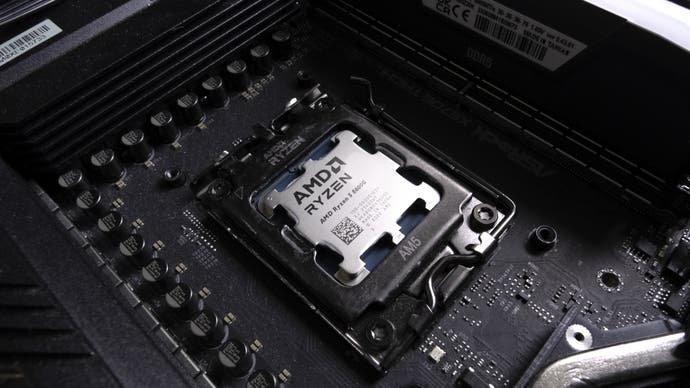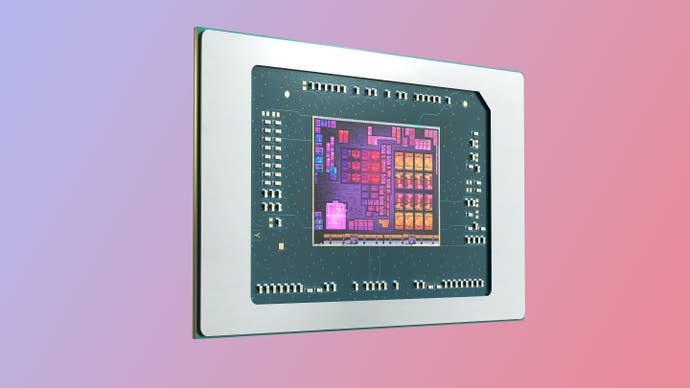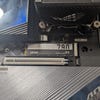AMD Ryzen 7 8700G and Ryzen 5 8600G review: integrated graphics for the win
Affordable chips that pair nicely with discrete GPUs too.
AMD's first Ryzen 8000 desktop processors are here: the $329/£309 8700G, $229/£219 8600G, $176/£169 8500G and OEM-only 8300G. These 4nm APUs look to be adaptations of the Ryzen 7040 laptop processors we tested late last year, with current-gen Zen 4 CPU cores and powerful RDNA 3 graphics capabilities. AMD sent us the top two chips, the Ryzen 7 8700G and Ryzen 5 8600G, which come with dedicated Ryzen AI hardware not afforded to the rest of the stack.
To get the measure of these new models, we've tested their performance both standalone (page two) and when paired with a discrete graphics card (pages three to five). On both counts, we've uncovered some impressive capabilities - which could make a Ryzen 8700G or 8600G a canny pick for straight-up entry-level gaming, media PCs or as a stop-gap solution while waiting for a next-generation graphics card.
Looking at the specs makes for fascinating reading. While the eight-core Ryzen 8700G and six-core 8600G are separated by a sizeable $100 MSRP gap, the two chips are surprisingly similar in most respects, with the 8700G boasting only 2MB of extra L2 cache (8MB vs 6MB), 100MHz higher rated boost speed (5.1GHz vs 5.0GHz) and a beefier Wraith Spire cooler versus the smaller Wraith Stealth provided with the 8600G. TDP, L3 cache size and AI performance are all the same. However, greater differences are evident in GPU performance, with the 8700G getting a more capable 12CU Radeon 780M graphics solution versus the 8600G's 8CU 760M.

| CPU design | Boost | Base | L3 cache | TDP | RRP | |
|---|---|---|---|---|---|---|
| Ryzen 7 8700G | Zen 4 8C/16T | 5.1GHz | 4.2GHz | 16MB | 65W | $329 |
| Ryzen 5 8600G | Zen 4 6C/12T | 5.0GHz | 4.3GHz | 16MB | 65W | $229 |
| Ryzen 5 8500G | Zen 4 6C/12T | 5.0GHz | 3.5GHz | 16MB | 65W | $176 |
| Ryzen 3 8300G | Zen 4 4C/8T | 4.9GHz | 3.4GHz | 8MB | 65W | OEM-only |
| Ryzen 9 7950X3D | Zen 4 16C/32T | 5.7GHz | 4.2GHz | 128MB | 120W | $699/£699 |
| Ryzen 9 7950X | Zen 4 16C/32T | 5.7GHz | 4.5GHz | 64MB | 170W | $699/£739 |
| Ryzen 9 7900X3D | Zen 4 12C/24T | 5.6GHz | 4.4GHz | 128MB | 120W | $599/£599 |
| Ryzen 9 7900X | Zen 4 12C/24T | 5.6GHz | 4.7GHz | 64MB | 170W | $549/£579 |
| Ryzen 9 7900 | Zen 4 12C/24T | 5.4GHz | 3.7GHz | 64MB | 65W | $429/£519 |
| Ryzen 7 7800X3D | Zen 4 8C/16T | 5.0GHz | 4.2GHz | 96MB | 120W | $449/£375 |
| Ryzen 7 7700X | Zen 4 8C/16T | 5.4GHz | 4.5GHz | 32MB | 105W | $399/£419 |
| Ryzen 7 7700 | Zen 4 8C/16T | 5.3GHz | 3.8GHz | 32MB | 65W | $329/£349 |
| Ryzen 5 7600X | Zen 4 6C/12T | 5.3GHz | 4.7GHz | 32MB | 105W | $299/£319 |
| Ryzen 5 7600 | Zen 4 6C/12T | 5.1GHz | 3.8GHz | 32MB | 65W | $229/£249 |
| Ryzen 5 7500F | Zen 4 6C/12T | 5.0GHz | 3.7GHz | 32MB | 65W | $200/£255* |
*Includes A620 motherboard
Before we get into our results, it makes sense to briefly cover the hardware we're testing these CPUs with. In short, we're using the same basic setup as our Ryzen 7800X3D review. That means AMD-recommended G.Skill Trident Z5 Neo DDR5-6000 CL30 RAM and Asus' RTX 3090 Strix OC graphics card. Cooling is provided by an Eisbaer Aurora 240mm AiO.
Our motherboard for AMD Ryzen 7000 CPUs is the ASRock X670E Taichi, while the Gigabyte Aorus Z790 Master takes care of our Intel CPUs. (AMD did also send on a cheaper ASRock B650 Pro RS board that's a more sensible choice for a low-cost APU, but we didn't want to unnecessarily introduce another variable into our testing.)
For storage, we're using a 4TB Lexar NM790 PCIe 4.0 NVMe SSD and a 1TB Corsair MP600 Mini for some additional games. Our rig is completed with a 1000W Corsair RM1000x power supply. Testing was performed with the latest Windows updates and BIOS revisions (2.06.AS03 Beta) installed.
Before we get into the iGPU and CPU gaming benchmarks that make up pages three to six, let's quickly run through some quick content creation benchmarks: a Cinebench R20 3D render and a Handbrake video transcode. These results are useful even in a gaming context as they set expectations for both single-core and multi-core performance.
Cinebench's R20 single-thread benchmark shows only a small gap between the two APUs, with the 8700G at 664 and the 8600G at 621 - both noticeably behind the 700s recorded for Ryzen 7000 desktop CPUs and more in line with prior-gen Ryzen 5000 models - not unexpected for an APU based on a laptop part that dedicates much of its die area to graphics.
The multi-core results also show reduced performance against the full-fat desktop Ryzen 7000 CPUs, with the 8700G trailing the 7700X despite having the same core count (6888 vs 7894) and the same to be said for the 8600G and 7600X (5304 vs 6063). Still, these are still well ahead of Ryzen 5000 parts, meaning that you won't be heavily disadvantaged even in the most demanding multi-core workloads.
| CB R20 1T | CB R20 MT | HB h.264 | HB HEVC | HEVC Power Use | |
|---|---|---|---|---|---|
| Ryzen 7 8700G | 664 | 6888 | 43.86fps | 20.83fps | 216W |
| Ryzen 5 8600G | 621 | 5304 | 36.46fps | 17.89fps | 195W |
| Ryzen 9 7950X3D | 788 | 13807 | 95.73fps | 40.70fps | 232W |
| Ryzen 9 7950X | 798 | 14837 | 105.15fps | 45.10fps | 368W |
| Ryzen 9 7900X | 791 | 11324 | 79.38fps | 33.77fps | 288W |
| Ryzen 7 7800X3D | 706 | 7108 | 52.99fps | 23.14fps | 190W |
| Ryzen 7 7700X | 768 | 7894 | 56.69fps | 25.95fps | 266W |
| Ryzen 5 7600X | 750 | 6063 | 44.35fps | 20.28fps | 236W |
| Ryzen 5 7600 | 706 | 5632 | 41.09fps | 18.72fps | 196W |
| Ryzen 5 7500F | 665 | 5574 | 40.78fps | 18.57fps | 193W |
| Ryzen 9 5950X | 637 | 10165 | 70.28fps | 30.14fps | 237W |
| Ryzen 7 5800X3D | 546 | 5746 | 42.71fps | 19.10fps | 221W |
| Ryzen 7 5800X | 596 | 6118 | 44.18fps | 19.50fps | 229W |
| Ryzen 5 5600X | 601 | 4502 | 31.75fps | 14.43fps | 160W |
| Core i9 14900K | 896 | 15962 | 103.12fps | 41.20fps | 433W |
| Core i5 14600K | 800 | 9349 | 62.68fps | 27.29fps | 288W |
| Core i9 13900K | 873 | 15570 | 104.67fps | 41.20fps | 473W |
| Core i5 13600K | 767 | 9267 | 62.37fps | 26.44fps | 254W |
| Core i9 12900K | 760 | 10416 | 70.82fps | 29.26fps | 373W |
| Core i7 12700K | 729 | 8683 | 57.64fps | 25.67fps | 318W |
| Core i5 12600K | 716 | 6598 | 44.27fps | 19.99fps | 223W |
| Core i5 12400F | 652 | 4736 | 31.77fps | 14.70fps | 190W |
| Core i9 11900K | 588 | 5902 | 41.01fps | 18.46fps | 321W |
| Core i5 11600K | 541 | 4086 | 29.00fps | 13.12fps | 250W |
The Handbrake video transcode test is a more realistic example of a probable workload for anyone recording video - often you record uncompressed video and need to compress it down before sharing it - and shows similar results.
The ~44fps and ~36fps averages here for h.264 encoding place the two APUs a tier down from where their core count would indicate - the 7800G closely resembles the 7600X, while the 7600G trails the 7500F by some margin. HEVC encoding is slower, as it always is, with ~21fps and ~18fps results that are similarly solid but uninspiring. Power usage doesn't appear markedly improved versus Ryzen 7000 alternatives of the same core count, though of course running these APUs without a graphics cards attached would result in lower total power draw.
Now, let's get into the meat and potatoes of our testing - a range of games and scenes that test these APUs' integrated graphics and raw processing grunt in different ways. Pick out your favourite titles from the links below or just hit the next page button to continue.
AMD Ryzen 7 8700G and Ryzen 5 8600G analysis
- Introduction, test rig and content creation benchmarks [this page]
- iGPU gaming benchmarks: F1 23, CS:GO, Far Cry 6, Cyberpunk 2077
- Gaming benchmarks: Flight Simulator 2020, Hitman 3, Ashes of the Singularity
- Gaming benchmarks: Counter-Strike: GO, Metro Exodus EE, Black Ops Cold War
- Gaming benchmarks: Cyberpunk 2077, Far Cry 6, Crysis 3 Remastered
- AMD Ryzen 7 8700G and Ryzen 5 8600G: the Digital Foundry verdict













